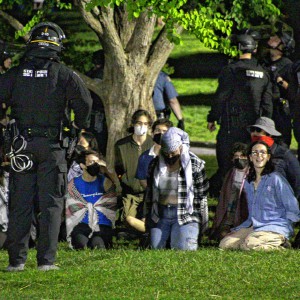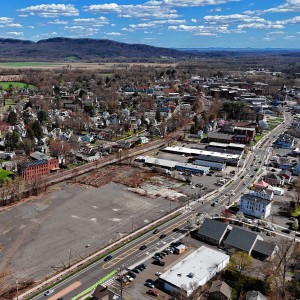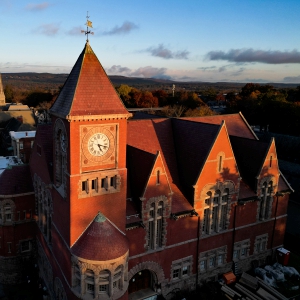State research project aims to study bear population size, distribution
| Published: 09-24-2023 3:44 PM |
Experts say that if you encounter a bear it is important to immediately make yourself look big, talk very calmly and slowly back away.
But after that, if you saw the carnivoran mammal in Massachusetts, you can go to bit.ly/3raabc8 to report the specifics of your sighting so professional and citizen scientists can learn about the population size and distribution of black bears in the state.
MassBears is a research project in collaboration with the state Division of Fisheries and Wildlife, the Massachusetts Cooperative Fish and Wildlife Research Unit, Amherst College and the University of Massachusetts Amherst. This project, which includes an interactive website, aims to estimate population size and distribution and provide other information about bear movement and conflict with humans.
“The more data you have, the better picture you can get of what’s happening,” said Dr. Thea Kristensen, a member of Amherst College’s biology department and this project’s leader. “This gives a way for our community in Massachusetts to participate in the project.”
Kristensen said she works closely with Amherst College undergraduate students Anna Zhou and Kea Cabaniero, who collect the submitted sightings data and update the interactive map found at bit.ly/450U9ii. The map documents sightings reported since 2019. Zhou, who is working toward bachelor’s degrees in English and statistics, said at least 1,300 sightings have been submitted, with at least 50% of them coming from either Franklin and Hampshire counties. She said those involved with the project want to increase the numbers of participants and communities reporting sightings.
“I think it will give us a better idea of what is happening with the bears,” Kristensen said. “Real-time information ... is immensely valuable.”
She said people in Massachusetts can report bears they see in person, on security footage or on trail cameras. It takes a few days for a submitted sighting to be included on the map, which is speckled with bear icons. Clicking on any of the icons brings up information about the sighting, including the date and time, location and what the bear was doing.
Cabaniero, who is double-majoring in environmental studies and political science, stressed it is vital to never approach a wild bear and to avoid running away or climbing trees, as this will make a human appear like prey. Kristensen said bears do not wake up craving human flesh and will leave people alone if not threatened or approached.
Article continues after...
Yesterday's Most Read Articles
 More than 130 arrested at pro-Palestinian protest at UMass
More than 130 arrested at pro-Palestinian protest at UMass
 Public gets a look at progress on Northampton Resilience Hub
Public gets a look at progress on Northampton Resilience Hub
 Northampton bans auto dealerships near downtown; zone change won’t affect Volvo operation on King Street
Northampton bans auto dealerships near downtown; zone change won’t affect Volvo operation on King Street
 UMass basketball: Bryant forward Daniel Rivera to be Minutemen’s first transfer of the offseason
UMass basketball: Bryant forward Daniel Rivera to be Minutemen’s first transfer of the offseason
 Town manager’s plan shorts Amherst Regional Schools’ budget
Town manager’s plan shorts Amherst Regional Schools’ budget
 Police respond to alcohol-fueled incidents in Amherst
Police respond to alcohol-fueled incidents in Amherst
Dave Wattles, the head black bear and furbearer biologist for MassWildlife, said black bears are the only bears in the state, with brown bears (also known as grizzly bears) limited to the Pacific Northwest. “The bear of the East is the black bear,” he said.
Wattles said MassBears, which he has no involvement with, can be a useful tool if enough residents learn of it. He mentioned the bear distribution depicted on the interactive map should be taken “with a grain of salt,” because the barrage of sightings reported in Hampshire County could be the result of the research project being based there. For instance, he said, one could glean from the map that there are not many bears in Berkshire County, “but we know there’s tons and tons of bears there.”
Wattles, who has been in his position since 2016, said the map enables the public to be the state’s “eyes and ears,” which can be especially helpful for tracking and studying bears that appear sick. He said there are an estimated 4,500 to 5,000 bears in Massachusetts, with that number growing steadily.
Residents can reduce the likelihood of attracting bears by removing bird feeders from their yards, keeping trash in a shed or garage and using electric fencing around chicken coops, Wattles said.
In September 2020, home security footage went viral of Greenfield resident Matthew Bete being woken up by the gentle poke of a bear while dozing in a lounge chair near his swimming pool on Lakeview Drive. Bete is seen being startled awake before the bear runs off. He quickly shared his experience with his wife, Dawn, who later posted the footage on her Facebook page, and as of 3:20 p.m. on Tuesday it had received 516,000 views, with 1,200 reactions and 675 comments.
The video, which contains no sound, was shared by media outlets around the world, from CNN to the Daily Mail (in the United Kingdom) to The Indian Express, an English-language newspaper based in India.
Reach Domenic Poli at: dpoli@recorder.com or 413-930-4120.

 State Senate budget funds free community college for all
State Senate budget funds free community college for all ‘We can just be who we are’: Thousands show support for LGBTQ community at Hampshire Pride
‘We can just be who we are’: Thousands show support for LGBTQ community at Hampshire Pride Doors open at Tilton Library’s temporary home at South Deerfield Congregational Church
Doors open at Tilton Library’s temporary home at South Deerfield Congregational Church Area property deed transfers, May 2
Area property deed transfers, May 2
